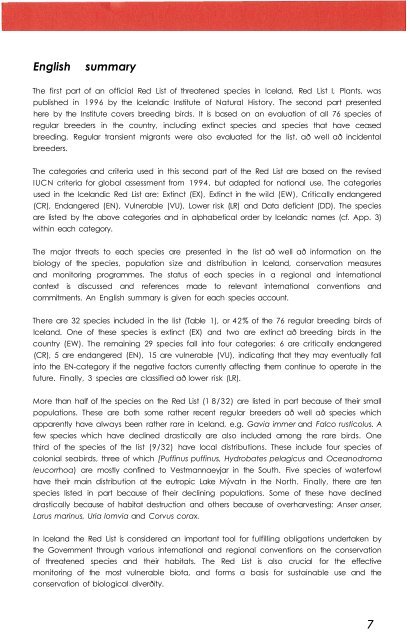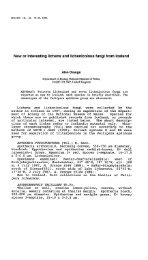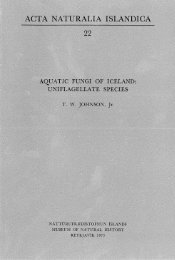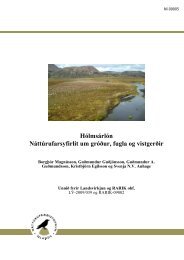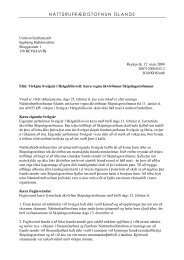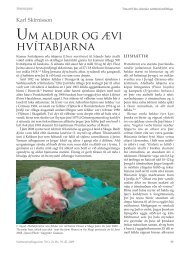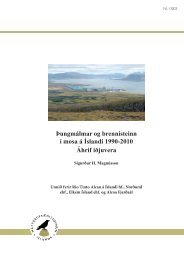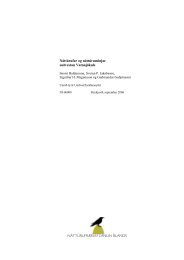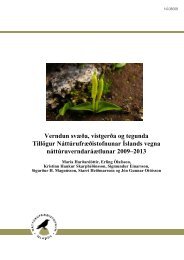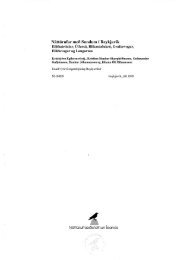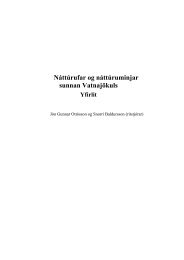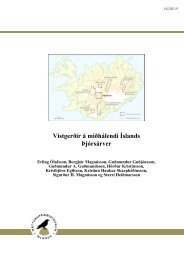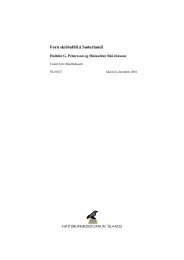Create successful ePaper yourself
Turn your PDF publications into a flip-book with our unique Google optimized e-Paper software.
English<br />
summary<br />
The first part of an official Red List of threatened species in lceland, Red List I, Plants, was<br />
published in 1996 by the lcelandic Institute of Natural History. The second part presented<br />
here by the Institute covers breeding birds. It is based on an evaluation of all 76 species of<br />
regular breeders in the country, including extinct species and species that have ceased<br />
breeding. Regular transient migrants were also evaluated for the list, að well að incidental<br />
breeders.<br />
The categories and criteria used in this second part of the Red List are based on the revised<br />
IUCN criteria for global assessment from 1994, but adapted for national use. The categories<br />
used in the lcelandic Red List are: Extinct (EX), Extinct in the wild (EW), Critically endangered<br />
(CR), Endangered (EN), Vulnerable (VU), Lower risk (LR) and Data deficient (DD). The species<br />
are listed by the above categories and in alphabetical order by lcelandic names (cf. App. 3)<br />
within each category.<br />
The major threats to each species are presented in the list að well að information on the<br />
biology of the species, population size and distribution in lceland, conservation measures<br />
and monitoring programmes. The status of each species in a regional and international<br />
context is discussed and references made to relevant international conventions and<br />
commitments. An English summary is given for each species account.<br />
There are 32 species included in the list (Table 1), or 42% of the 76 regular breeding birds of<br />
lceland. One of these species is extinct (EX) and two are extinct að breeding birds in the<br />
country (EW). The remaining 29 species fall into four categories: 6 are critically endangered<br />
(CR), 5 are endangered (EN), 15 are vulnerable (VU), indicating that they may eventually fall<br />
into the EN-category if the negative factors currently affecting them continue to operate in the<br />
future. Finally, 3 species are classified að lower risk (LR).<br />
More than half of the species on the Red List (1 8/32) are listed in part because of their small<br />
populations. These are both some rather recent regular breeders að well að species which<br />
apparently have always been rather rare in lceland, e.g. Gavia immer and Falco rusticolus. A<br />
few species which have declined drastically are also included among the rare birds. One<br />
third of the species of the list (9/32) have local distributions. These include four species of<br />
colonial seabirds, three of which [Puffinus puffinus, Hydrobates pelagicus and Oceanodroma<br />
leucorrhoa) are mostly confined to Vestmannaeyjar in the South. Five species of waterfowl<br />
have their main distribution at the eutropic Lake Mývatn in the North. Finally, there are ten<br />
species listed in part because of fheir declining populations. Some of these have declined<br />
drastically because of habitat destruction and others because of overharvesting: Anser anser,<br />
Larus marinus, Uria lomvia and Corvus corax.<br />
In lceland the Red List is considered an important tool for fulfilling obligations undertaken by<br />
the Government through various international and regional conventions on the conservation<br />
of threatened species and their habitats. The Red List is also crucial for the effective<br />
monitoring of the most vulnerable biota, and forms a basis for sustainable use and the<br />
conservation of biological diverðity.<br />
7


